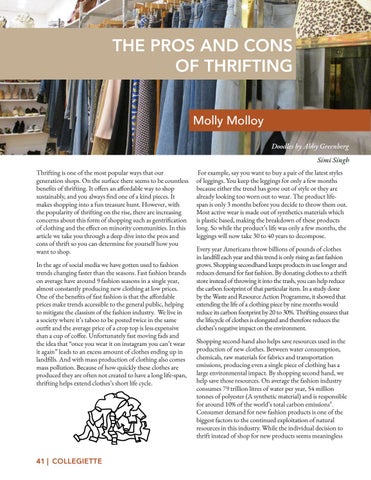THE PROS AND CONS OF THRIFTING Molly Molloy Doodles by Abby Greenberg Simi Singh Thrifting is one of the most popular ways that our generation shops. On the surface there seems to be countless benefits of thrifting. It offers an affordable way to shop sustainably, and you always find one of a kind pieces. It makes shopping into a fun treasure hunt. However, with the popularity of thrifting on the rise, there are increasing concerns about this form of shopping such as gentrification of clothing and the effect on minority communities. In this article we take you through a deep dive into the pros and cons of thrift so you can determine for yourself how you want to shop. In the age of social media we have gotten used to fashion trends changing faster than the seasons. Fast fashion brands on average have around 9 fashion seasons in a single year, almost constantly producing new clothing at low prices. One of the benefits of fast fashion is that the affordable prices make trends accessible to the general public, helping to mitigate the classism of the fashion industry. We live in a society where it’s taboo to be posted twice in the same outfit and the average price of a crop top is less expensive than a cup of coffee. Unfortunately fast moving fads and the idea that “once you wear it on instagram you can’t wear it again” leads to an excess amount of clothes ending up in landfills. And with mass production of clothing also comes mass pollution. Because of how quickly these clothes are produced they are often not created to have a long life-span, thrifting helps extend clothes’s short life cycle.
41 | COLLEGIETTE
For example, say you want to buy a pair of the latest styles of leggings. You keep the leggings for only a few months because either the trend has gone out of style or they are already looking too worn out to wear. The product lifespan is only 3 months before you decide to throw them out. Most active wear is made out of synthetics materials which is plastic based, making the breakdown of these products long. So while the product’s life was only a few months, the leggings will now take 30 to 40 years to decompose. Every year Americans throw billions of pounds of clothes in landfill each year and this trend is only rising as fast fashion grows. Shopping secondhand keeps products in use longer and reduces demand for fast fashion. By donating clothes to a thrift store instead of throwing it into the trash, you can help reduce the carbon footprint of that particular item. In a study done by the Waste and Resource Action Programme, it showed that extending the life of a clothing piece by nine months would reduce its carbon footprint by 20 to 30%. Thrifting ensures that the lifecycle of clothes is elongated and therefore reduces the clothes’s negative impact on the environment. Shopping second-hand also helps save resources used in the production of new clothes. Between water consumption, chemicals, raw materials for fabrics and transportation emissions, producing even a single piece of clothing has a large environmental impact. By shopping second hand, we help save those resources. On average the fashion industry consumes 79 trillion litres of water per year, 54 million tonnes of polyester (A synthetic material) and is responsible for around 10% of the world’s total carbon emissions³. Consumer demand for new fashion products is one of the biggest factors to the continued exploitation of natural resources in this industry. While the individual decision to thrift instead of shop for new products seems meaningless















